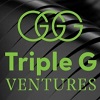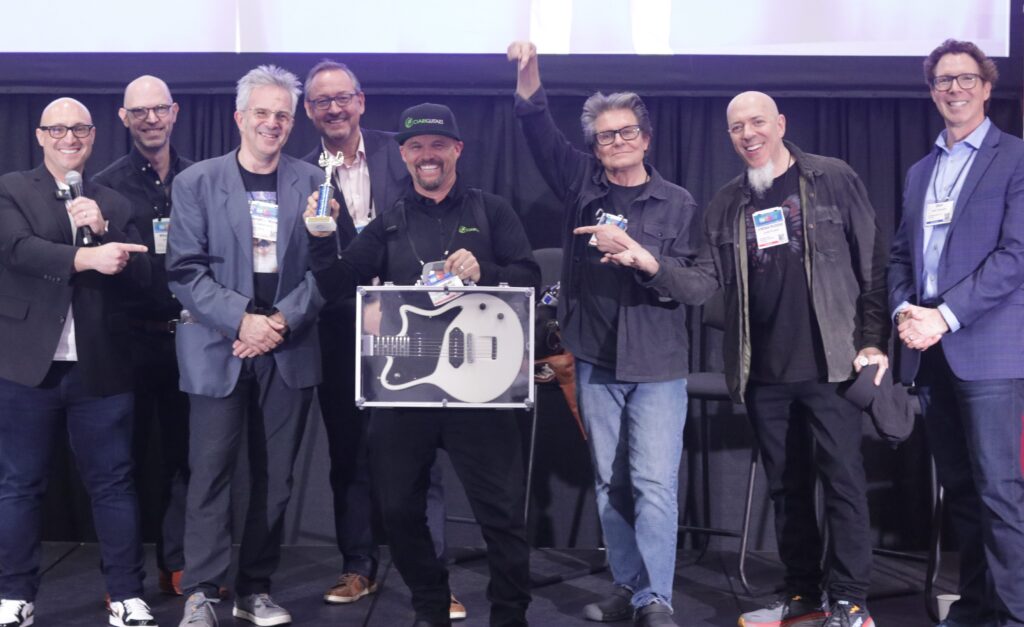Triple G Ventures Pitch Competition 2024
Triple G Ventures Pitch Competition 2024
Article by Angie Kibiloski
Perfect Pitch
On the opening evening of The NAMM Show 2024, Triple G Ventures hosted their inaugural Pitch Competition at the Anaheim Convention Center, for start-up companies to pitch their new music tech innovations to a panel of influential judges. Each contestant had 10 minutes to impress the panel with their ideas, and then another 5 minutes to answer follow-up questions. At the end, the judges scored each entry and chose a winner to receive some fabulous prizes, including guidance on their project and a booth at The NAMM Show 2025. There were 6 companies that took to the stage, and I’ll give them all a quick rundown here, starting with the clear, outstanding winner and working my way down the judges’ rankings. I’ll include what the judges thought of each, as well as my own impressions as a layperson.
Bend More Than Notes
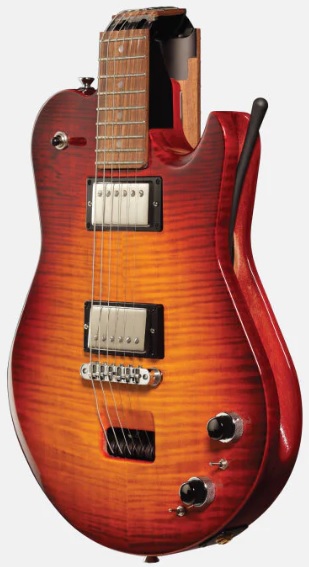 Congratulations to Ciari Guitars for being the judges’ top choice (and mine) and snagging the win! Jonathan Spangler has created the coolest electric guitars with his debut Ascender series, that fold down at the neck for easy travel and storage. Traveling with a full-size guitar can be a hassle, especially on an airplane, but a Ciari Ascender can fit in a backpack to store under the seat as a carry-on personal item. Hand-built by master craftsmen in Nashville, TN, each Ciari Ascender is a full, 7.5 lb., professional guitar, with no sacrifice to stage-worthy quality. The innovations in design that make the fold possible include a mid-neck hinge, a floating bridge, and a mechanism that automatically loosens and retightens the strings to accommodate the fold.
Congratulations to Ciari Guitars for being the judges’ top choice (and mine) and snagging the win! Jonathan Spangler has created the coolest electric guitars with his debut Ascender series, that fold down at the neck for easy travel and storage. Traveling with a full-size guitar can be a hassle, especially on an airplane, but a Ciari Ascender can fit in a backpack to store under the seat as a carry-on personal item. Hand-built by master craftsmen in Nashville, TN, each Ciari Ascender is a full, 7.5 lb., professional guitar, with no sacrifice to stage-worthy quality. The innovations in design that make the fold possible include a mid-neck hinge, a floating bridge, and a mechanism that automatically loosens and retightens the strings to accommodate the fold.
All the judges were unanimously impressed with this guitar, having very little evident criticism, several of them saying they’d love to be play testers and take one out on the road with them. I really loved this product as well, was rooting for it the whole time in fact, and though I’m only a novice, if I played gigs outside my own living room, I’d want one too. A Ciari Ascender is a bit pricy, coming in at $1,600-$2,100, so they aren’t necessarily for an average hobbyist. If you’re a musician on-the-go, though, Ciari Guitars may have your next go-to travel companion.
Amped Up and Social
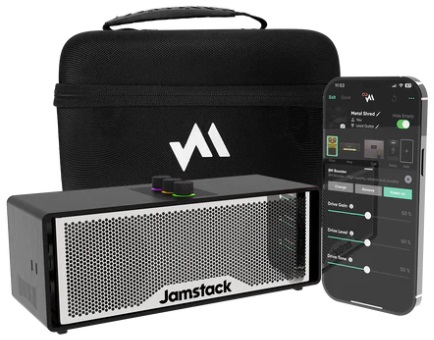 Next down the judges’ picks was the Jamstack 2, developed by Chris Pendergast, which is a smart amp module that plugs into the base of your guitar, either directly at the lower strap peg or via cable, and connects wirelessly to a mobile app. The $399 hardware has built-in pedal effects, backing tracks, Bluetooth speaker, and on-board tuner, along with more features from the connected app. That app is a combination of a mobile, AI-powered mini-DAW and social networking and collab platform. It helps you adjust settings and effects parameters, record tracks within its interface, share multi-track recordings and presets with other musicians, and connect with creators to collab on projects.
Next down the judges’ picks was the Jamstack 2, developed by Chris Pendergast, which is a smart amp module that plugs into the base of your guitar, either directly at the lower strap peg or via cable, and connects wirelessly to a mobile app. The $399 hardware has built-in pedal effects, backing tracks, Bluetooth speaker, and on-board tuner, along with more features from the connected app. That app is a combination of a mobile, AI-powered mini-DAW and social networking and collab platform. It helps you adjust settings and effects parameters, record tracks within its interface, share multi-track recordings and presets with other musicians, and connect with creators to collab on projects.
The judges had mixed feelings on the hardware itself, especially with it’s attachment compatibility with guitars of variable body shapes, but seemed to have a more favorable view on the networking and collaboration aspects of the software, though even on that they were divided. I find the sharing of multi-tracks with potential collab partners to be a nice app feature, though I feel like this need is already solved by simply sharing your existing DAW’s session files, so for me the most useful tool in the app is the networking aspect, to find and share presets and tracks with a wider group of musicians. Decide for yourself at Jamstack.io
Mixing for Dummies
 The panel’s 3rd choice was Osmix from Jared Forman, a plug-in that fully automates the mixing process, simplifying it down to a one-dial interface for music makers who aren’t pro engineers. You just import your audio stems, tag each one with a track category and instrument, choose a mixing theme filter, and turn the big dial to adjust the level to which the chosen filter will be applied to your source. You can adjust the volumes of each instrument track, but otherwise there are no other controls beyond exporting your final mix. Osmix has a proposed cost of $30 per song, which is a bit of a hefty price tag, though there are plans for a subscription model if you produce a lot of content volume.
The panel’s 3rd choice was Osmix from Jared Forman, a plug-in that fully automates the mixing process, simplifying it down to a one-dial interface for music makers who aren’t pro engineers. You just import your audio stems, tag each one with a track category and instrument, choose a mixing theme filter, and turn the big dial to adjust the level to which the chosen filter will be applied to your source. You can adjust the volumes of each instrument track, but otherwise there are no other controls beyond exporting your final mix. Osmix has a proposed cost of $30 per song, which is a bit of a hefty price tag, though there are plans for a subscription model if you produce a lot of content volume.
The judges didn’t like the lack of transparency behind the controls, and not being able to look under the hood to see the processes that Osmix was using. They agreed that part of crafting a perfect song is finetuning the mix parameters yourself. They also thought the price was a bit much. Even as a total novice to mixing myself, I still like to be able to see what’s being done to my tracks, and I enjoy playing around and tweaking the presets in other mixing plug-ins. Mixing plug-ins, I might add, that I’ve bought outright for the cost of 3 of their automated mixes. Osmix might be perfect for creators with neither time nor experience to manually mix their content, and want a quick and easy solution, but maybe not for those who want a more hands-on, creative approach to their final mix.
The AI Future of HR
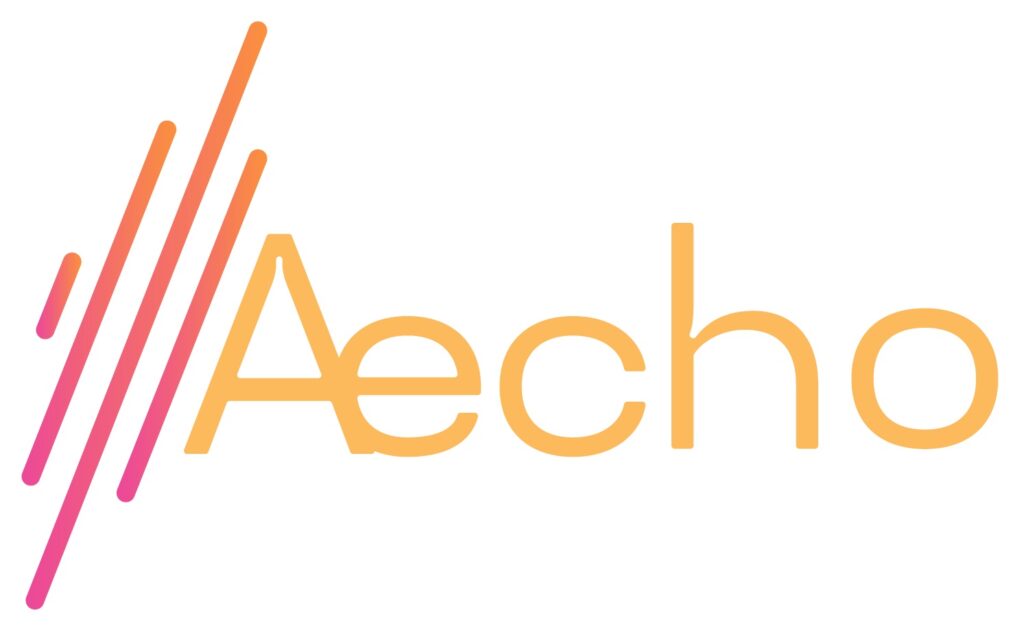 Rounding the corner to the back half of the contestants, we have Aecho from Adam Hocek, an AI system for HR departments. It uses psychometric analysis of vocal tones to help identify potential emotional or psychological issues with employees, and determine if they’ll be right for a job, or a continued asset within the company once hired. It can use just 2 minutes of recorded speech to analyze 164 emotional and psychological traits to make this determination, with an 80% rate of accuracy. Other applications for this software can be for personal use, to analyze your own personality and communication style, in an educational setting to monitor the mental and emotional health of students, as well as performance and future career alignment, or for research and clinical trial purposes.
Rounding the corner to the back half of the contestants, we have Aecho from Adam Hocek, an AI system for HR departments. It uses psychometric analysis of vocal tones to help identify potential emotional or psychological issues with employees, and determine if they’ll be right for a job, or a continued asset within the company once hired. It can use just 2 minutes of recorded speech to analyze 164 emotional and psychological traits to make this determination, with an 80% rate of accuracy. Other applications for this software can be for personal use, to analyze your own personality and communication style, in an educational setting to monitor the mental and emotional health of students, as well as performance and future career alignment, or for research and clinical trial purposes.
The judges brought up the potential ineffectiveness due to the variances of what people might be asked to say in those 2 minutes, as the scripts are not standardized by the developers of Aecho. Rather, they’re left up to the discretion of the client or HR team. They also didn’t feel like 80% accuracy was good enough. Personally, I find the whole thing a bit dystopian. It’s difficult enough for job seekers as it is, having to get their resumes past gatekeeping AI filters just to be seen by human eyes. To then potentially lose a job opportunity because another AI didn’t like their vocal tone is a step too far for my liking.
Gamifying Virtual Concerts
 Next to last was Intusic, a future metaverse that will serve as a video game platform and live concert venue, currently in development by Jeremy Tisser. Virtual concert attendees will enjoy livestreamed performances in real-time, via the cameras set up at corresponding IRL venues. Instead of seeing the real environment of the stage, however, the software transposes the live performers onto the virtual world created within the metaverse, so your favorite band might be playing in a lava pit or at the top of a mountain. During set breaks, or before and after the performance, attendees can socialize with each other via their avatars, and during the performance, they can either simply spectate or earn rewards by playing PvP games together in the virtual pit.
Next to last was Intusic, a future metaverse that will serve as a video game platform and live concert venue, currently in development by Jeremy Tisser. Virtual concert attendees will enjoy livestreamed performances in real-time, via the cameras set up at corresponding IRL venues. Instead of seeing the real environment of the stage, however, the software transposes the live performers onto the virtual world created within the metaverse, so your favorite band might be playing in a lava pit or at the top of a mountain. During set breaks, or before and after the performance, attendees can socialize with each other via their avatars, and during the performance, they can either simply spectate or earn rewards by playing PvP games together in the virtual pit.
The panel’s reactions were a mix of approval and skepticism, with the weight leaning more towards the latter. They thought the single camera view that was proposed at the live event end of things was far too limiting, and didn’t really create an immersive metaverse experience. They also thought the proposed subscription model of payment wasn’t workable, with the lack of available partnered performances being the biggest setback. Personally, if I’ve paid to attend a live event, even in the digital space, I’m going to want to watch the performance, not engage in PvP battles with the music in the background. However, there may be others who thrive on divided attention and need more stimulation than just watching a concert would provide. If this sounds like you, then Intusic might be right up your alley.
Internal Effects
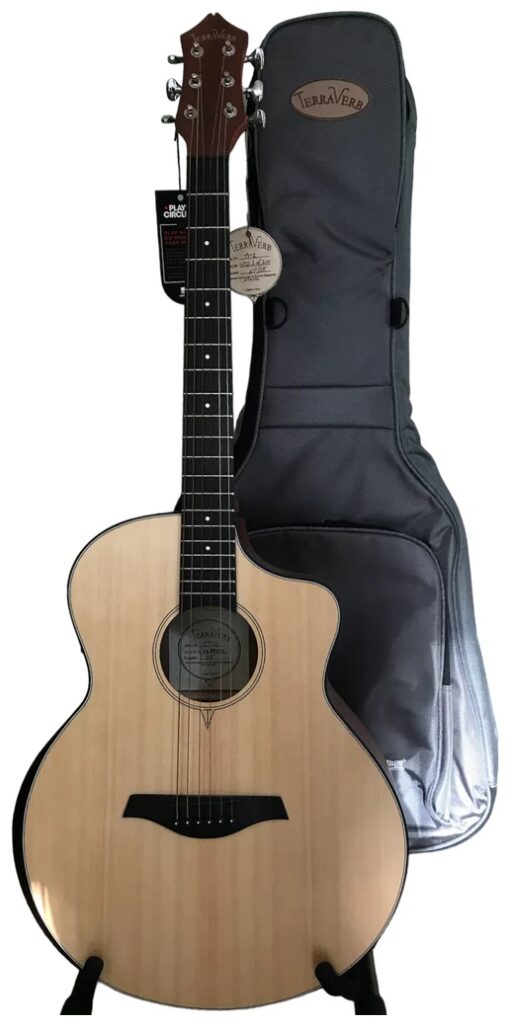 Finally, the entry that came in last was the TerraVerb acoustic guitar from Stephen Kriksciun at Waveform Audio. The limited-edition TV1 model is an acoustic-electric guitar with a built-in HyVibe preamp and actuators on the body, a multi-track looper with overdubbing, and Bluetooth playback compatibility. Its on-board effects include reverb, phaser, delay, distortion, and a dozen more, and are controlled by an interface of tactile buttons and knobs with no touchscreen. With the free mobile companion app, you can create new sounds, blend and stack effects, and control external playback.
Finally, the entry that came in last was the TerraVerb acoustic guitar from Stephen Kriksciun at Waveform Audio. The limited-edition TV1 model is an acoustic-electric guitar with a built-in HyVibe preamp and actuators on the body, a multi-track looper with overdubbing, and Bluetooth playback compatibility. Its on-board effects include reverb, phaser, delay, distortion, and a dozen more, and are controlled by an interface of tactile buttons and knobs with no touchscreen. With the free mobile companion app, you can create new sounds, blend and stack effects, and control external playback.
After learning that TerraVerb‘s own innovative contribution was just to bring the tech from other companies like HyVibe together to build their guitar, the panel as a whole was less impressed than if all the elements had been engineered in-house. I can see where they’re coming from with this opinion, and though it’s a nice guitar, it does seem pretty basic, and I can understand why they placed it last. Still, the TerraVerb TV1 is, in fact, a nice guitar with some good on-board features, so go see for yourself where it would’ve ranked on your list.
Lining Up the Next Pitch
This year was the 1st time Triple G Ventures hosted their Pitch Competition, and I’d say it was a resounding success. I fully enjoyed listening to the contestants explain their products, some with more finesse than others, and then waiting with anticipation to see if my opinions and pick for winner matched up with the professional judges’ critiques and choices. There are already plans in the works for next year’s competition, and I can’t wait to find out who will try their luck, and what cool music tech they’ll present. If you’re interested in other news from Triple G Ventures, or you think you might have an innovation worthy of pitching to a panel of music professionals at The NAMM Show 2025, sign up for their mailing list to be kept up to date on when you can register to compete.

